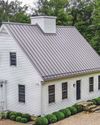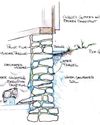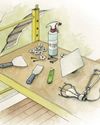
Restorers are an unusual breed. What motivates these unsung heroes of preservation to take on a decades or centuries-old house for the first, second, or umpteenth time? I asked that question of more than a dozen folks who’ve been featured for their good work in OHJ.
Some responders are serial restorers who say they get antsy as one project nears completion. Others have renovated properties in different locales, whenever life took them to a new place. One or two have invested in a house with deep roots, and are still hard at work restoring homes that have been in the family for decades.
Then we have Alex and Wendy Santantonio, who admit to naively thinking they’d finish their first renovation (of an 1885 row house in Alexandria, Virginia) in three years. It’s been 17 so far. “It’s almost as if our home found us, two suckers that would pour our hearts into its upkeep,” says Alex. “Now I can’t imagine ever owning a house that isn’t at least 100 years old.”
Anyone who’s lived through restoration knows that it’s messy, exhausting, expensive, and usually poses at least one seemingly insurmountable problem. Even a simple project like skim-coating a hallway creates so much dust that it percolates into every room, says Bill Ticineto, who’s now working on his second major restoration. “Refinishing floors is a nightmare. All the furniture must be moved out of the room. You might as well stay at a hotel.”
Most of those we spoke to applied their own skills wherever they could, but subcontracted out jobs that require special expertise, such as electrical and plumbing work, structural work including shoring up or rebuilding the foundation, and heavy landscaping. That said, almost all recalled doing more of the dirty work in their earlier years, when youth and lack of money made hands-on restoration a necessity.
Diese Geschichte stammt aus der November - December 2019-Ausgabe von Old House Journal.
Starten Sie Ihre 7-tägige kostenlose Testversion von Magzter GOLD, um auf Tausende kuratierte Premium-Storys sowie über 8.000 Zeitschriften und Zeitungen zuzugreifen.
Bereits Abonnent ? Anmelden
Diese Geschichte stammt aus der November - December 2019-Ausgabe von Old House Journal.
Starten Sie Ihre 7-tägige kostenlose Testversion von Magzter GOLD, um auf Tausende kuratierte Premium-Storys sowie über 8.000 Zeitschriften und Zeitungen zuzugreifen.
Bereits Abonnent? Anmelden

Navigating the Lumberyard - Here's some lumber lingo you should know before you venture into a lumberyard.
Here's some lumber lingo you should know before you venture into a lumberyard. Almost everyone fixing an old house will end up at a lumberyard-whether it's a local supplier or the organized aisles of a big-box home-improvement store.

a farmhouse renewed
Sensitive renovations and restoration work preserved a house that dates to 1799.

AN OVERVIEW OF METAL ROOFING
METAL ROOFS ARE RESURGENT, FOR GOOD REASONS.

ENDURING BEAUTY IN WALLS of STONE
Now back in the family who had been here since 1830, the old farmhouse is again ready for generations to come. Additions dating to 1840 and the 1950s were preserved.

ARCHITECTURAL DETAILS COME TO LIFE
Owners and their designer celebrate the unique features of a 1912 Arts & Crafts Tudor.

For a Wet Basement Wall
If there's problem common to old houses, it's a wet basement. I'm not talking about occasional flooding, but rather a basement that apparently seeps or leaks after even a rain shower or during snowmelt. Several approaches are available; sustainable solutions will get to the root of the problem.

Patching a Plaster Wall
Fix a hole in the wall with a few common tools and some drywall supplies. Practice your technique!

Roofing & Siding
Make note of these historical and unusual materials for the building envelope.

The Riddle of the water
When water incursion happens, the roof isn't necessarily the culprit. Maybe snaking a drain line, or clearing debris from a clogged gutter, temporarily will stem a leak. But a recurring problem usually means other forces are at work. It takes persistence-and a team with the right skills and patience—to identify the source and apply a solution.

Light-filled Craftsman Redo
For a dark kitchen in a 1914 Illinois house, the trick was anchoring white expanses with woodsy warmth.